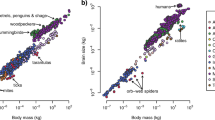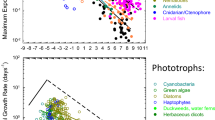Abstract
A long-standing problem has been the origin of quarter-power allometric scaling laws that relate many characteristics of organisms to their body mass1,2 — specifically, whole-organism metabolic rate, B = aMb, where M is body mass, a is a taxon-dependent normalization, and b ≈ 3/4 for animals and plants. Darveau et al.3 propose a multiple-cause model for mammalian metabolic rate as the “sum of multiple contributors”, Bi, which they assume to scale as Bi = , and obtain b ≈ 0.78 for the basal and 0.86 for the maximally active rate, \({\mathop V\limits^{\bullet}}{}_{{\rm O}_2}^{\max}\). We argue, however, that this scaling equation is based on technical, theoretical and conceptual errors, including misrepresentations of our published results4,5.
Similar content being viewed by others
Main
All of the results of Darveau et al.3 follow from their equation (2), B = , which they neither derive nor prove. As control coefficients6, ci, and exponents, bi, are dimensionless, this must be incorrect because it violates dimensional homogeneity, leading to different results for b that depend on the units of mass: for the basal rate, b = 0.76 when M is in kilograms, and b = 1.08 when M is in picograms.
Now, by definition, ci ≡ ∂lnB/∂lnBi, which leads to the standard sum rules6 Σci = 1 and Σciɛi = 0, where ɛi = b − bi with b(M) ≡ dlnB/dlnM, the slope of lnB versus lnM, and bi(M) ≡ dlnBi/dlnM. This gives b = Σcibi, the equations that Darveau et al. should have used to determine b from the empirical ci and bi. These formulae are very general, requiring no assumptions about how B and Bi scale, or whether the Bi are connected in parallel or in series. Darveau et al., however, use B = ΣBi, implying that the Bi are added in parallel and, as such, their model is simply a consistency check on the conservation of energy, which requires all “ATP-utilizing processes”3 (in parallel) to sum to B and so must be trivially correct. This gives ci = (ai/a) and B = aΣ(), which is the (dimensionally) correct version of equation (2).
As Darveau et al. take a and ai as constant, their ci must scale as . However, they assume that ci (and bi) ∝ M0, which requires b (which equals Σcibi)∝M0, thereby contradicting their equation (2), in which b depends on M. This inconsistency in the M-dependence of b is concealed in their plots, which cover only three orders of magnitude in M, over which b is almost constant (about 0.78 for basal). However, when their analysis is extended to the realistic eight orders of magnitude spanned by mammals, their b increases with M to an average value of about 0.85 and, for \({\mathop V\limits^{\bullet}}{}_{{\rm O}_2}^{\max}\), to about 0.98, which are both inconsistent with other data1,2.
Darveau et al. have taken their value for bi from empirical data, without explaining why B, or bi, scales nonlinearly with M, or why most bi ≈ 3/4. Understanding these features is the real challenge — the formulation of Darveau et al. is therefore hardly fundamental. By contrast, our theory4,5 is grounded in basic principles of geometry, physics and biology, and offers a general unifying explanation for these and the other quarter-power scalings that are so pervasive in biology.
References
Schmidt-Nielsen, K. Scaling: Why is Animal Size So Important? (Cambridge Univ. Press, Cambridge, UK, 1984).
Peters, R. H. The Ecological Implications of Body Size (Cambridge Univ. Press, Cambridge, UK, 1983).
Darveau, C.-A., Suarez, R. K., Andrews, R. D. & Hochachka, P. W. Nature 417, 166–170 (2002).
West, G. B., Brown, J. H. & Enquist, B. J. Science 276, 122–126 (1997).
West, G. B., Brown, J. H. & Woodruff, W. H. Proc. Natl Acad. Sci. 99, 2473–2478 (2002).
Westerhoff, H. V. & Dam, K. Thermodynamics and Control of Biological Free-Energy Transduction (Elsevier, Amsterdam, 1987).
Author information
Authors and Affiliations
Corresponding author
Rights and permissions
About this article
Cite this article
West, G., Savage, V., Gillooly, J. et al. Why does metabolic rate scale with body size?. Nature 421, 713 (2003). https://doi.org/10.1038/421713a
Issue Date:
DOI: https://doi.org/10.1038/421713a
This article is cited by
-
Is Population Genetics Really Relevant to Evolutionary Biology?
Evolutionary Biology (2024)
-
Scaling-up ecosystem functions of coastal heterogeneous sediments: testing practices using high resolution data
Landscape Ecology (2022)
-
Scaling of work and energy use in social insect colonies
Behavioral Ecology and Sociobiology (2016)
-
Physiological underpinnings associated with differences in pace of life and metabolic rate in north temperate and neotropical birds
Journal of Comparative Physiology B (2014)
-
Low global sensitivity of metabolic rate to temperature in calcified marine invertebrates
Oecologia (2014)
Comments
By submitting a comment you agree to abide by our Terms and Community Guidelines. If you find something abusive or that does not comply with our terms or guidelines please flag it as inappropriate.



